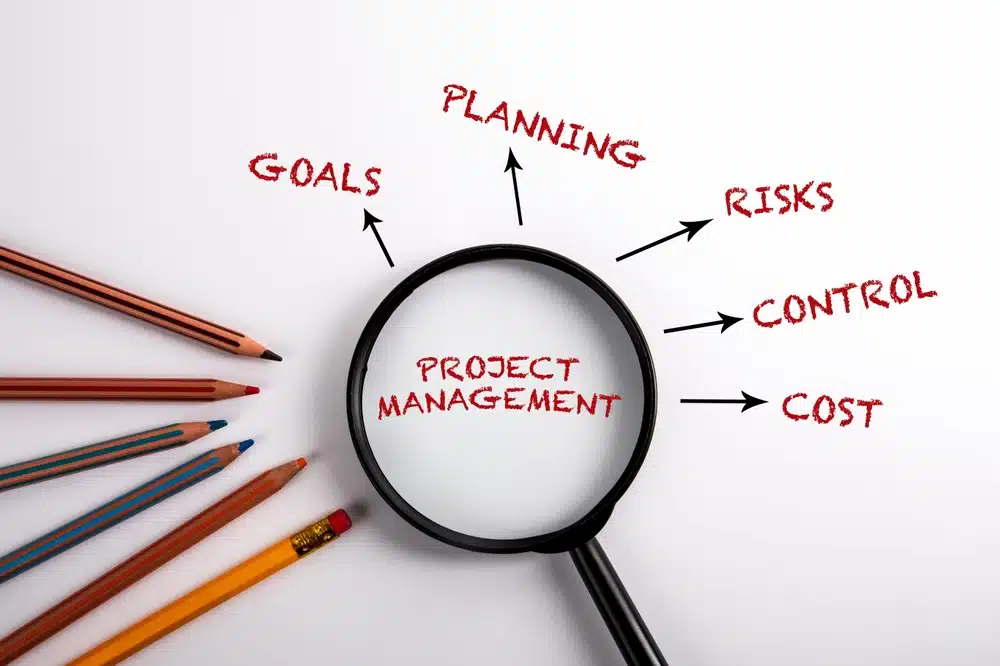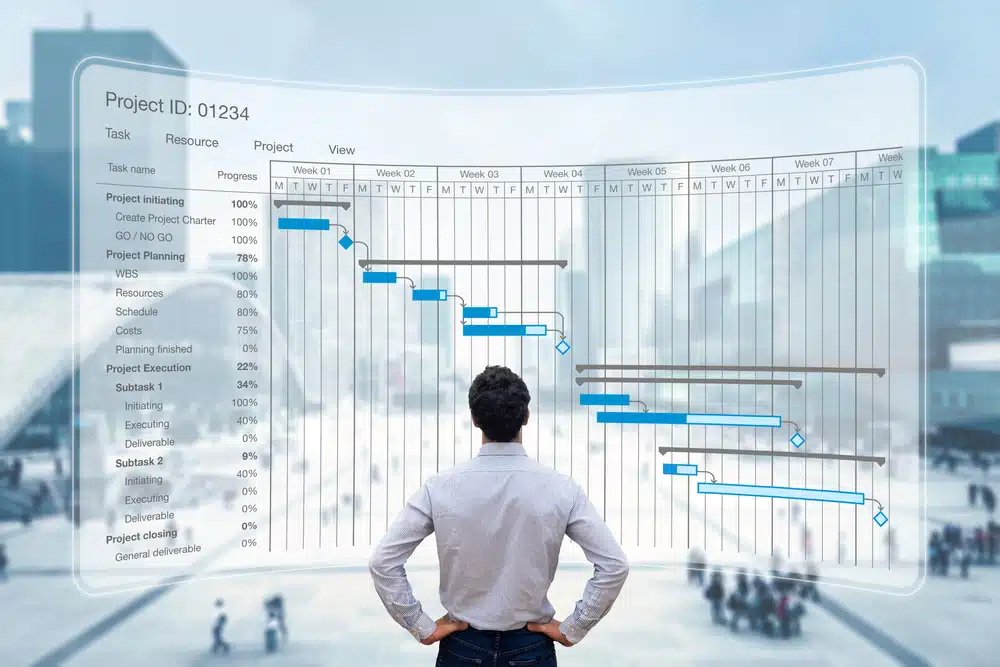Project planning is vital for successful project management. It sets the foundation for execution and outcomes. The Project Management Institute links effective planning to project success. A well-crafted plan serves as a roadmap for project completion.
During planning, the project manager develops a comprehensive plan. It covers requirements, goals, resources, and timelines. This plan keeps the project organized and aligned with expectations. It provides a complete view of the project lifecycle.
A good plan enables teams to collaborate effectively. It boosts productivity and helps navigate challenges. Teams can work together more smoothly with a clear plan in place.
Crafting a project plan involves several key components. These include defining scope, setting SMART goals, and identifying stakeholders. It also requires outlining deliverables and creating a detailed schedule.
Project managers break down deliverables into actionable tasks. They assign responsibilities and highlight dependencies. This ensures smooth progression and helps mitigate potential risks.
Effective planning keeps projects on track. It also enhances team motivation and engagement. Research shows motivated employees understand their work’s impact on company objectives. However, only 26% of employees have this clarity.
Key Takeaways:
- Project planning is crucial for successful project execution and outcomes.
- A comprehensive project plan serves as a roadmap, providing clarity and direction.
- Key components of a project plan include scope, goals, stakeholders, deliverables, and schedule.
- Effective project planning enhances team motivation, collaboration, and productivity.
- Breaking down deliverables into actionable tasks and highlighting dependencies ensures smooth project progression.
What is Project Planning?
Project planning lays the foundation for success in project management. It defines scope, sets goals, and identifies resources. This phase creates timelines, establishes budgets, and anticipates challenges. Thorough planning mitigates risks and ensures smooth execution.
Definition of Project Planning
Project planning determines steps, resources, and timelines for project completion. It breaks down projects into manageable tasks and assigns responsibilities. This process creates a roadmap for execution, aligning stakeholders and optimizing resources.
Stages of Project Management Lifecycle
The project management lifecycle comprises four main stages:
- Project Initiation: This stage defines purpose, scope, and objectives. It identifies stakeholders, assesses feasibility, and obtains approvals.
- Project Planning: Here, we develop a detailed plan with tasks, milestones, and timelines. We establish success metrics and create risk management strategies.
- Project Execution: We implement the plan, coordinating team efforts and monitoring progress. Regular communication keeps the project on track.
- Project Closure: We review deliverables, document lessons learned, and release resources. This stage includes celebrating achievements and formally closing the project.
Following these stages and dedicating time to planning sets the stage for success. It helps deliver projects that meet or exceed stakeholder expectations.
Effective project planning is the key to unlocking project success. It provides a clear roadmap, aligns stakeholders, and sets the stage for seamless project execution.
The Importance of Project Plans
Project plans are vital for success, guiding teams from start to finish. They ensure stakeholder alignment, accountability, and collaboration towards a common goal. Project planning lays the foundation for effective teamwork and increased visibility.
It’s crucial for visualizing the entire project lifecycle. Breaking down projects into manageable tasks helps develop clear strategies. Team members can better understand their roles and contributions to the bigger picture.
Visualizing the Project from Start to Finish
Project planning allows us to see the whole project journey. It breaks down tasks into smaller, manageable pieces. This visual representation helps team members grasp their roles and responsibilities.
Team members can see how their work fits into the overall project. This clarity improves understanding and motivation throughout the project’s lifecycle.
Keeping Stakeholders Aligned and Accountable
Project plans keep stakeholders aligned and accountable. They define objectives, timelines, and deliverables clearly. This ensures everyone works towards the same goals.
A well-crafted plan facilitates communication and transparency. It becomes easier to spot risks, make informed decisions, and adapt to changes. This alignment improves overall project outcomes.
| Benefits of Project Planning | Statistical Impact |
|---|---|
| Increased stakeholder satisfaction and collaboration | 94% of stakeholders report increased satisfaction when project objectives are clearly outlined |
| Improved project success rate | 65% of projects with meticulous planning have a higher success rate in meeting objectives |
| Cost savings through efficient resource allocation | 72% of organizations experience cost savings through comprehensive project planning |
| Reduction in delays and schedule overruns | 78% reduction in delays and overruns observed in projects that prioritize effective time management |
Enhancing Team Collaboration and Productivity
Effective planning fosters seamless teamwork. It defines roles clearly, helping members understand their contributions. This ownership boosts morale and productivity, leading to better outcomes.
86% of Project Managers believe that Project Planning is essential for successful Project execution.
A well-structured plan prevents team overload by mapping schedules and balancing workloads. It identifies potential bottlenecks and optimizes resource allocation. This support helps team members perform at their best.
Effective workload management increases job satisfaction and reduces turnover rates. Employees are more likely to stay with organizations that prioritize smart planning.
Key Components of a Project Plan
A comprehensive project plan is crucial for success. It guides teams through project stages and aligns everyone. Let’s explore the key components of a robust project plan.
Project Scope and Goals
A clear project scope forms the foundation. It outlines specific goals and objectives to achieve. Well-defined scope prevents scope creep and keeps the team focused.
It ensures desired outcomes are delivered within allocated resources and timelines. This helps maintain project boundaries and expectations.
Project Schedule and Milestones
The project schedule outlines task timelines and key milestones. Breaking down the project into manageable tasks helps effectively manage time and resources.
The schedule should account for task dependencies. It should include contingency time for unexpected delays or challenges.
Resource Allocation and Budget
Effective resource allocation is vital for project success. Identify required resources, including team members, equipment, materials, and budget. Careful allocation and monitoring optimize efficiency and budget control.
| Resource Type | Allocation Considerations |
|---|---|
| Human Resources | Assign tasks based on skills, experience, and availability |
| Equipment and Materials | Ensure timely procurement and availability of necessary resources |
| Budget | Allocate funds strategically to cover project expenses and contingencies |
Risk Management Strategy
Every project has risks. A risk management strategy is crucial. Identify potential risks early and develop contingency plans and mitigation strategies.
Regular risk assessments throughout the project lifecycle help maintain proactivity. They allow teams to adapt their approach as needed.
According to recent studies, projects that adhere to a well-defined project plan are 25% more likely to meet their set milestones and timelines, and teams that follow a predetermined project plan are 30% more likely to achieve project success compared to those without a clear plan.
These key components create a solid foundation for successful project execution. A comprehensive plan guides the team and aligns all stakeholders.
It serves as a powerful communication tool. This ensures everyone works towards a common goal effectively.
Steps to Create a Project Plan
A comprehensive project plan is crucial for successful project execution. Following a structured approach ensures all critical aspects are covered. Your team will be well-prepared to tackle challenges ahead.
- Define project goals and objectives
- Identify project deliverables and milestones
- Break down deliverables into tasks
- Determine task dependencies and sequence
- Estimate task durations and resource requirements
- Create a project timeline and schedule
- Assign roles and responsibilities
- Develop a communication plan
- Identify and assess potential risks
- Establish a budget and resource allocation plan
- Review and finalize the project plan
- Continuously monitor and adjust the plan as needed
These steps create a solid foundation for your project. They ensure stakeholder alignment and provide a clear roadmap for the team. Thorough, realistic, and adaptable planning is key to project success.
According to the Project Management Institute’s 2020 Pulse of the Profession report, 11.4% of business investment is wasted due to poor project performance. Effective project planning is crucial for minimizing risks, improving efficiency, and ensuring alignment among team members.
Jacques Alexis, an assistant teaching professor at Northeastern University, emphasizes planning’s critical role in project management. He stresses the importance of engaging stakeholders throughout the plan creation process.
Early stakeholder involvement yields valuable insights. It helps set realistic expectations and builds a shared vision for project success.
| Project Plan Component | Description |
|---|---|
| Project Overview | Provides a high-level summary of the project, including its purpose, objectives, and key stakeholders. |
| Scope Statement | Defines the boundaries of the project, specifying what is included and excluded from the project scope. |
| Work Breakdown Structure (WBS) | Breaks down the project deliverables into smaller, manageable tasks and subtasks. |
| Project Schedule | Outlines the timeline for completing project tasks, milestones, and deliverables. |
| Resource Allocation Plan | Identifies the resources (human, financial, and material) required to complete the project and how they will be allocated. |
| Risk Management Plan | Identifies potential risks, assesses their impact, and outlines strategies for mitigating or responding to them. |
| Communication Plan | Defines how project information will be shared among stakeholders, including the frequency, format, and channels of communication. |
Incorporating these essential components into your project plan ensures thorough consideration of all aspects. Your team will be well-equipped to deliver successful results.
Defining Project Scope and Success Metrics
Defining project scope is vital for success. It protects against scope creep and keeps the project on track. Let’s explore key elements of scope definition and success metrics.
Crafting a Project Purpose Statement
A project purpose statement captures the project’s essence. It answers critical questions about goals, stakeholders, importance, methods, and timeline. This brief ensures team alignment and focus on shared objectives.
- What are we trying to achieve?
- Who are the key stakeholders involved?
- Why is this project important?
- How will we accomplish our goals?
- When do we expect to complete the project?
Establishing Performance Criteria and Quality Standards
Success metrics help track progress and identify areas for improvement. They determine if we’ve achieved our goals. Key metrics include Gross Profit Margin, Customer Satisfaction Score, and Schedule Variance.
Cost Variance and Resource Utilization are also crucial. These metrics guide data-driven decisions and project adjustments. Regular monitoring ensures we stay on course and deliver desired results.
| Metric | Description | Formula |
|---|---|---|
| Gross Profit Margin (GPM) | Measures the team’s contribution to overall profit | (Gross profit / revenue) x 100 |
| Customer Satisfaction Score | Measures client satisfaction with the project deliverables | (Total point score from survey / Number of questions) x 100 |
| Schedule Variance | Indicates whether the project is ahead or behind schedule | Work scheduled to date – Work actually completed to date |
| Cost Variance | Determines if the project is on track financially | Planned budget – Actual costs |
| Resource Utilization | Measures the effectiveness of human resources | (Staff hours clocked for project / Total staff hours assigned) x 100 |
Defining project scope and success metrics is not a one-time exercise. As the project progresses, we may need to revisit and refine these elements based on stakeholder feedback and changing circumstances.
Investing time in scope definition and success metrics sets projects up for success. It ensures value delivery to stakeholders. Regular refinement based on feedback keeps the project aligned with changing needs.
Identifying Key Project Stakeholders
Identifying and engaging key project stakeholders is crucial for effective project planning. These individuals shape the project’s trajectory from start to finish. Project managers must prioritize stakeholders based on their power, interest, and potential impact.
Stakeholders fall into two main categories: internal and external. Internal stakeholders include team members and executives within the organization. External stakeholders comprise customers, users, suppliers, and investors. Understanding each group’s expectations and influence is vital for successful project management.
Clarifying Roles and Responsibilities
After identifying key stakeholders, it’s essential to clarify their roles and responsibilities. This ensures everyone understands their part in the project and can contribute effectively. Tools like Confluence can facilitate virtual collaboration sessions to define and document these roles.
Clear roles and responsibilities offer several benefits. They ensure accountability and ownership among team members. They help identify skill gaps and allocate resources accordingly. They also streamline communication and decision-making processes.
- Ensure accountability and ownership among team members
- Identify skill gaps and allocate resources accordingly
- Streamline communication and decision-making processes
- Avoid duplication of efforts and minimize conflicts
Ensuring Cross-Functional Collaboration
Cross-functional collaboration is often necessary for successful project planning and execution. Project managers must foster an environment that encourages teamwork and open communication across different departments. This approach promotes knowledge sharing and enhances overall project outcomes.
To promote cross-functional collaboration, several strategies can be employed. Regular meetings and status updates with stakeholders are essential. Using collaboration tools helps share project documents and timelines effectively. Encouraging open dialogue and seeking feedback from stakeholders is crucial.
- Schedule regular meetings and status updates with stakeholders
- Use collaboration tools to share project documents, timelines, and deliverables
- Encourage open dialogue and actively seek feedback from stakeholders
- Celebrate milestones and successes to boost team morale and engagement
Effective stakeholder engagement is both an art and a science. It requires a deep understanding of stakeholder needs, expectations, and communication preferences, as well as the ability to adapt and respond to changing project dynamics.
Identifying key stakeholders, clarifying roles, and ensuring collaboration builds a strong foundation for successful projects. Early investment in stakeholder engagement yields significant benefits. These include improved project outcomes, increased team satisfaction, and stronger long-term relationships.
Outlining Project Deliverables
Project deliverables are tangible outcomes created during a project. They must be within scope, agreed upon by stakeholders, and contribute to objectives. Deliverables vary in size and complexity, from stadiums to marketing documents.
Deliverables can be external (client-oriented) or internal (organizational). External deliverables include business case documents, status reports, and final products. Internal deliverables comprise team meetings, project plans, and lessons learned documents.
Process deliverables facilitate project progression without directly delivering requirements. Examples include scope change processes, team meetings, and resource management plans. Product deliverables directly fulfill project requirements, forming part of the final product or service.
Well-defined deliverables help reduce scope creep, minimize delays, and align team efforts towards project success.
Project milestones are checkpoints marking important activities and tracking progress. They comprise smaller, tangible tasks that teams produce. Signposts guide teams on a day-to-day or weekly basis.
To outline project deliverables effectively, follow these steps:
- Create a list of deliverables that will help achieve the greater vision of the project.
- Clearly outline the project’s concrete and tangible deliverables or outcomes.
- Centralize these deliverables in a project management tool with designated cards for each one to keep work moving forward.
Tracking project deliverables offers numerous benefits, including:
- Efficient project scheduling
- Optimized resource management
- Improved team alignment
- Meeting stakeholder expectations
- Accurate risk projection and estimates
| Deliverable Type | Examples |
|---|---|
| Process Deliverables | Scope change process, team meetings, lessons learned sessions, resource management plan |
| Product Deliverables | Web application feature, house foundations, customer documentation, architectural design |
| External Deliverables | Business case documents, project status reports, final product or service |
| Internal Deliverables | Project plans, sprint backlogs, lessons learned documents |
Proper management of project deliverables leads to accurate estimates and optimized resources. It also aligns teams, meets stakeholder expectations, and mitigates risks. Research shows 37% of projects fail due to poorly defined objectives and milestones.
Breaking Down Deliverables into Actionable Tasks
Breaking down key deliverables into smaller, manageable tasks is crucial for project success. This process ensures efficient project execution and team alignment. By creating actionable tasks, we provide clarity and direction for each team member, boosting productivity and collaboration.
Consider various types of project deliverables when breaking them down. These include internal and external processes, as well as internal and external products. Creative teams may focus on tasks like blog posts and website wireframes. Product teams might prioritize roadmaps, UI wireframes, and customer retention reports.
Identifying Task Dependencies
Recognizing dependencies between tasks is vital when breaking down deliverables. Task dependencies occur when one task relies on another’s completion. Highlighting these relationships allows for better planning and prioritization, ensuring a smooth workflow.
Examples of task dependencies include:
- A website wireframe must be approved before the design team can begin creating the final graphics.
- Market research must be conducted before the marketing team can develop a targeted campaign strategy.
- The foundation of a house must be laid before the walls can be constructed.
Prioritizing and Assigning Tasks
After breaking down deliverables and identifying dependencies, prioritize and assign tasks to team members. Effective prioritization ensures focus on critical and time-sensitive tasks. Consider each team member’s workload and skills when assigning responsibilities.
Key factors for task prioritization include:
| Factor | Description |
|---|---|
| Urgency | How soon does the task need to be completed? |
| Importance | How critical is the task to the overall success of the project? |
| Dependencies | Does the task rely on the completion of other tasks? |
| Skillset | Which team member has the necessary skills to complete the task efficiently? |
By breaking down our deliverables into actionable tasks, identifying dependencies, and prioritizing and assigning tasks effectively, we can create a clear and organized project plan that sets our team up for success.
Effective task management requires open communication and regular progress reviews. Stay agile and responsive to ensure project success. Adapt as needed to keep your project on track and deliver desired results.
Developing a Project Timeline
A well-crafted project timeline is essential for successful project management. It visually represents the project’s schedule, task sequences, and durations. This tool helps managers handle workloads and adapt to changing needs effectively. It includes task dependencies, resource allocation, and milestones.
The timeline guides the entire project team dynamically. Creating it starts with defining the project scope and objectives. The project brief aligns all stakeholders with common goals. Tasks should be displayed chronologically for comprehensiveness and flexibility.
Estimating Task Durations
Estimating task durations is crucial for building a project timeline. This process involves breaking down the project into smaller, manageable tasks. Assessing time for each task helps identify potential bottlenecks and allocate resources effectively.
Project managers should work closely with team members to estimate accurately. They can leverage their expertise and experience. The three-point estimation technique considers best-case, most likely, and worst-case scenarios. This method provides realistic estimates and accounts for potential risks.
Creating a Gantt Chart
A Gantt chart visually represents project timelines, showing task relationships, durations, and dependencies. It helps track progress, identify critical paths, and make informed decisions. Project managers can keep projects on schedule using this tool.
When creating a Gantt chart, it’s essential to:
- List all project tasks
- Determine task dependencies
- Estimate task durations
- Assign resources to each task
- Plot tasks on the timeline
Following these steps creates a comprehensive, visually appealing Gantt chart. It effectively communicates the project timeline to all stakeholders. This tool enhances project management and team coordination. For further details, please read our comprehensive guide on Gantt Chart with Definitions & Examples.
Building in Contingency Time
Unforeseen circumstances can arise in any project. Building contingency time into the timeline mitigates potential delays or setbacks. This buffer allows flexibility and helps keep the project on track.
Contingency time should be carefully considered and allocated based on the complexity and risk level of each task. As a general rule, it’s recommended to add a 10-20% buffer to the estimated duration of each task.
Incorporating contingency time creates a more resilient and adaptable plan. This approach increases the likelihood of project success. It helps managers handle unexpected challenges more effectively.
A comprehensive project timeline is crucial for effective project planning. Estimating task durations, creating Gantt charts, and including contingency time are key steps. These elements establish a clear path and maintain the big picture.
A well-crafted timeline keeps everyone informed and prevents bottlenecks. It makes adapting to change easier and paves the way for project success. Effective timelines are essential tools for project managers and teams.
Allocating Resources and Creating a Budget
Resource allocation and project budgeting are vital for successful project management. They ensure timely completion, budget adherence, and quality standards. Proper allocation streamlines workflows, reduces delays, and boosts efficiency by aligning project phases with specific requirements.
Planning resource usage helps identify potential bottlenecks before they impact timelines. This foresight enhances client satisfaction. A well-crafted allocation strategy optimizes resources, increasing the likelihood of meeting project objectives.
Merging dashboards with automation enhances project management efficiency by providing visual, intuitive overviews of resource distribution and streamlining tracking and allocation processes.
Consider these best practices when allocating resources and creating a project budget:
- Allocate resources during the project planning phase for an effective resource allocation strategy.
- Ensure project objectives are specific, time-bound, and attainable to guide resource allocation decisions.
- Understand available resources, including team capacity, budgets, tools, and required skills before allocating resources.
- Maintain a clear project scope to avoid scope creep and guide resource allocation decisions.
- Monitor project progress in real-time to allow for adjustments in resource allocation if unexpected changes occur.
Project budgeting involves estimating and allocating funds for project completion. It considers costs like labor, materials, equipment, software, overhead, and contingency. Successful budgeting aligns goals with broader business objectives and demonstrates strategic thinking.
| Resource Allocation | Project Budgeting |
|---|---|
| Assigning human and non-human resources (staff, contractors, facilities, tools, technology) to the project | Estimating and allocating funds for project completion within scope, time, and quality requirements |
| Balancing demand and supply, optimizing utilization, and managing dependencies, conflicts, and risks | Considering costs such as labor, materials, equipment, software, overhead, and contingency |
Risk-driven prioritization is crucial in project management. It involves allocating more resources to high-risk areas to ensure project success. Efficient allocation includes mentoring, optimizing resources, and avoiding overconsumption in critical areas.
In interviews, show knowledge of principles, methods, and tools for project budgeting and resource allocation. Provide examples of your experience in planning and managing project resources. Highlight your ability to adapt to different scenarios and optimize resource allocation.
What Is the Purpose of a Project Management Plan?
A project management plan guides teams through the project lifecycle. It outlines scope, objectives, timeline, budget, and resources for successful delivery. This plan provides a framework for execution, aligning stakeholders towards common goals.
A well-structured plan communicates vision, manages expectations, and fosters collaboration. It identifies risks, allocates resources efficiently, and monitors progress against milestones. This crucial tool ensures timely, on-budget delivery that satisfies all stakeholders.
The Elements of A Project Plan
A typical project plan includes several key components. These project management plan elements work together to provide a holistic view of the project.
- Project scope and objectives
- Project schedule and milestones
- Resource allocation and budget
- Risk management strategy
- Quality management plan
- Communication plan
- Change management plan
Each element plays a crucial role in project success. Defining scope prevents creep and maintains alignment with objectives. The schedule outlines the timeline, while budget allocation ensures necessary resources are available.
Techniques for the Project Planning Process
Project planning involves steps and techniques for creating an effective plan. These include brainstorming, mind mapping, Work Breakdown Structure (WBS), Gantt charts, and PERT.
- Brainstorming and mind mapping to generate ideas and identify project requirements
- Work Breakdown Structure (WBS) to break down the project into manageable tasks and deliverables
- Gantt charts to visualize the project timeline and dependencies
- PERT (Program Evaluation and Review Technique) to estimate task durations and identify the critical path
- Risk assessment and mitigation planning to identify and manage potential project risks
These techniques ensure thorough, realistic, and achievable plans. Regular reviews and updates maintain relevance throughout the project lifecycle.
How Long Does the Project Planning Phase Take?
Project planning duration varies based on complexity and size. On average, it takes 8-10% of total project time. Investing sufficient time in planning sets projects up for success.
Rushing through planning can lead to unrealistic expectations, missed deadlines, and budget overruns. Thorough planning is crucial for project success.
How To Make a Project Plan When You Don’t Have All the Answers
Creating a plan without all information requires informed assumptions and flexibility. Identify and document assumptions made during planning. Build contingency time and budget into the plan for uncertainties.
Regularly review and update the plan as new information becomes available. Communicate assumptions and limitations to stakeholders. This flexible approach helps navigate uncertainties and adapt for success.
How To Manage Your Project Plan
Effective plan management keeps projects on track. Key strategies include regular reviews, progress tracking, open communication, and change management.
| Strategy | Description |
|---|---|
| Regular reviews and updates | Regularly review and update the project plan to reflect changes in scope, timeline, or resources. This helps maintain the plan’s relevance and accuracy throughout the project lifecycle. |
| Progress tracking | Monitor project progress against the plan using tools like Gantt charts, burndown charts, or project dashboards. This helps identify deviations from the plan and enables timely corrective actions. |
| Communication and collaboration | Foster open communication and collaboration among team members and stakeholders. Regularly share updates on project progress, risks, and issues to ensure everyone is aligned and informed. |
| Change management | Establish a formal change management process to evaluate, approve, and implement changes to the project plan. This helps maintain control over the project scope and prevents unauthorized changes from derailing the project. |
Implementing these strategies ensures effective plan management and project success. Investing in comprehensive planning and diligent management is essential for delivering value-driven projects.
Conclusion
Effective project planning is crucial for successful delivery. A comprehensive plan sets the stage for triumph. It clarifies goals, scope, timeline, resources, and risks. This enables confident navigation through the project management lifecycle.
Our plan serves as a roadmap through each project stage. Clear objectives and efficient resource allocation minimize scope creep. Gantt charts can boost on-time delivery by 15%. A thorough risk strategy contributes to 90% of successful projects.
At PMtech Digital Solutions, we use advanced tools to optimize portfolio management. We align projects with strategic business goals. This approach enhances overall project success rates.
Effective communication and collaboration are vital for project execution. Clearly defined roles improve team accountability by 65%. Our plan ensures everyone understands their responsibilities. We foster cross-functional teamwork and regularly review stakeholder feedback.
A project plan should be flexible and adaptable. By embracing change and continuous improvement, we overcome challenges. This approach drives successful project outcomes and exceeds expectations.
In summary, effective planning is the foundation of project success. Dedication to comprehensive plans and best practices yields results. With the right approach, we transform ideas into reality and deliver meaningful outcomes.














